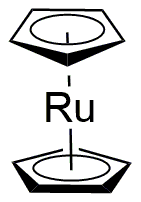Ruthenocene is widely utilized in research focused on:
- Catalysis: It serves as a catalyst in various chemical reactions, enhancing reaction rates and selectivity, particularly in organic synthesis. This is beneficial for industries looking to improve efficiency and reduce waste.
- Material Science: Ruthenocene is used in the development of advanced materials, including conductive polymers and nanocomposites, which are essential in electronics and energy storage applications.
- Medicinal Chemistry: Researchers explore its potential in drug development, particularly in targeting cancer cells, due to its unique properties that allow for selective interactions with biological molecules.
- Electrochemistry: It is applied in the creation of electrochemical sensors, providing high sensitivity and specificity for detecting various analytes, which is crucial for environmental monitoring and biomedical applications.
- Nanotechnology: Ruthenocene plays a role in the synthesis of nanoparticles, which are used in a variety of fields, including drug delivery systems and imaging technologies, offering advantages in precision and efficacy.
General Information
Properties
Safety and Regulations
Applications
Ruthenocene is widely utilized in research focused on:
- Catalysis: It serves as a catalyst in various chemical reactions, enhancing reaction rates and selectivity, particularly in organic synthesis. This is beneficial for industries looking to improve efficiency and reduce waste.
- Material Science: Ruthenocene is used in the development of advanced materials, including conductive polymers and nanocomposites, which are essential in electronics and energy storage applications.
- Medicinal Chemistry: Researchers explore its potential in drug development, particularly in targeting cancer cells, due to its unique properties that allow for selective interactions with biological molecules.
- Electrochemistry: It is applied in the creation of electrochemical sensors, providing high sensitivity and specificity for detecting various analytes, which is crucial for environmental monitoring and biomedical applications.
- Nanotechnology: Ruthenocene plays a role in the synthesis of nanoparticles, which are used in a variety of fields, including drug delivery systems and imaging technologies, offering advantages in precision and efficacy.
Documents
Safety Data Sheets (SDS)
The SDS provides comprehensive safety information on handling, storage, and disposal of the product.
Product Specification (PS)
The PS provides a comprehensive breakdown of the product’s properties, including chemical composition, physical state, purity, and storage requirements. It also details acceptable quality ranges and the product's intended applications.
Certificates of Analysis (COA)
Search for Certificates of Analysis (COA) by entering the products Lot Number. Lot and Batch Numbers can be found on a product’s label following the words ‘Lot’ or ‘Batch’.
Numéro de catalogue
Numéro de lot/série
Certificates Of Origin (COO)
This COO confirms the country where the product was manufactured, and also details the materials and components used in it and whether it is derived from natural, synthetic, or other specific sources. This certificate may be required for customs, trade, and regulatory compliance.
Numéro de catalogue
Numéro de lot/série
Safety Data Sheets (SDS)
The SDS provides comprehensive safety information on handling, storage, and disposal of the product.
DownloadProduct Specification (PS)
The PS provides a comprehensive breakdown of the product’s properties, including chemical composition, physical state, purity, and storage requirements. It also details acceptable quality ranges and the product's intended applications.
DownloadCertificates of Analysis (COA)
Search for Certificates of Analysis (COA) by entering the products Lot Number. Lot and Batch Numbers can be found on a product’s label following the words ‘Lot’ or ‘Batch’.
Numéro de catalogue
Numéro de lot/série
Certificates Of Origin (COO)
This COO confirms the country where the product was manufactured, and also details the materials and components used in it and whether it is derived from natural, synthetic, or other specific sources. This certificate may be required for customs, trade, and regulatory compliance.


